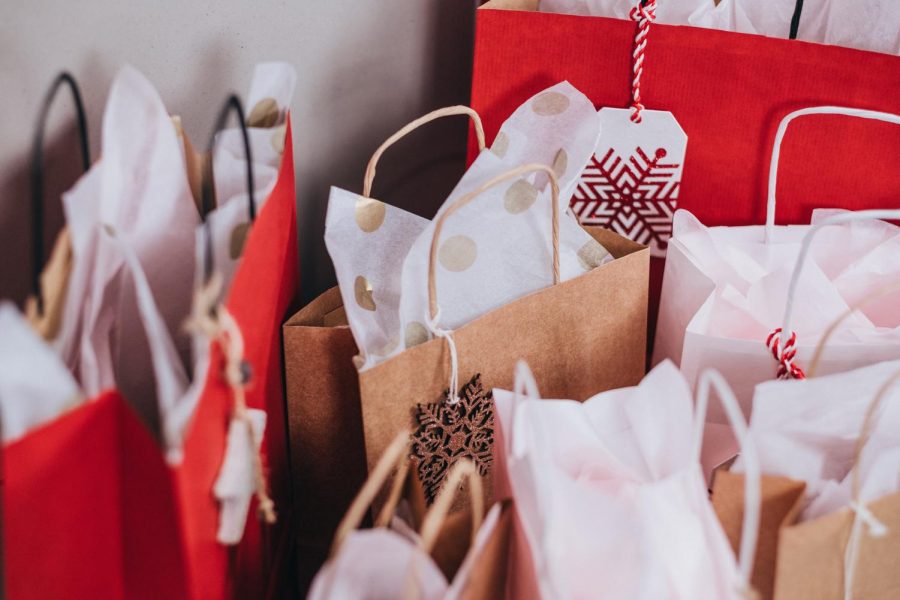Soter: Shop Local this Holiday Season
November 25, 2021
I love the holidays. Everything about them. I know that’s a controversial statement considering Thanksgiving celebrates colonization, Christmas celebrates capitalism and New Year’s celebrates another year closer to the world ending because of climate change. But still, I’d be lying if I said the holidays aren’t magical.
I truly believe the only thing more magical than receiving the perfect gift is giving it, and the holidays are the time for both. This is why I usually wait until the second week of December before I even start thinking about my shopping list, let alone put it into action.
This year though, my perfection-induced procrastination might not be an option. The broken supply chain keeps pushing delivery dates back and I am waking up from nightmares about a lonely Christmas tree. The solution is to shop local this holiday season. By doing so, we can support our neighbors and save ourselves from the collapsed capitalist supply chain.
What is the Supply Chain?
When the pandemic first started, it made sense that the supply chain broke. Millions of people around the world were rushing to obtain PPE with nobody working to send or manufacture more shipments, and they still are. Not to mention the number of people who, rightfully, thought the pandemic was the beginning of the apocalypse and stockpiled toilet paper, hand sanitizer and all the non-perishable food products they could find. But now, almost two years later, we are still hearing about the broken supply chain.
To break down these questions, we first need to understand what the global supply chain is and how it functions. In the simplest terms, the global supply chain is the relationship between the consumer and producer of a particular good or service. In more complicated terms, the global supply chain starts with raw goods which turns to products through distributors. The distributor gives it to a retailer who is able to make it available to the consumer, but this exchange is commonly time-consuming depending on the distance between the retailer and consumer.
For one product, this process makes sense. It’s not overly complicated. For every product in the world, things get a little confusing. This is especially true of the U.S., which has been a net importer and the largest trading country in the world. In 2019, before the pandemic hit, the country reported $5.6 trillion worth of goods that were imported or exported in a single year.
But beyond all this, the supply chain is reliant on exploitation to function. Through the severe manipulation of both the land and people, the supply chain can make its wealth. Take, for example, the sweatshop workers who only make $200 annually. While you may be thinking that this has no connection to America because we don’t have sweatshops here, our hands are far from clean. America is one of the countries keeping sweatshops viable because we support them. Products from tomatoes to garments to cigarettes are imported by the U.S. at cheap prices from sweatshops.
What Happened to the Supply Chain?
All that said, it’s not shocking that the pandemic affected the U.S. as aggressively as it did. When factories shut down, so did production. Shipping companies’ response to the shutdowns was more shutdowns. What was surprising was the way the public reacted. While companies thought they too would “shut down,” at least in terms of shopping, they did not. The exact opposite happened. I and the obscene number of unnecessary books I purchased during lockdown can attest. People were bored; online shopping kept them entertained. In 2018, the U.S. spent over $519 billion in online purchases, and that number isn’t getting smaller. According to Forbes, “62% of U.S. shoppers say they shop more online now than they did before the pandemic.” The supply chain couldn’t keep up. It still can’t.
Consumers and retailers ordered more from suppliers when their products didn’t arrive and as a result, ships got backed up at ports and couldn’t unload shipments. Because of this backlog, shipping containers themselves became more expensive and less available. Pre-pandemic, it cost about $2,000 to transport a shipping container from Shanghai to Los Angeles. Now, that same trip costs about $25,000. So, both economically and logistically speaking, it is unsurprising that shipping containers are scarce, putting the supply chain even further behind. Beyond all this, the cracks in the supply chain have led to severe inflation. As of September, it was reported that within the last 12 months the Consumer Price Index had increased by 5%.
Why Shopping Local is the Solution
As predictions report that the global supply chain will not fully recover until 2022, it’s clear that other holiday plans must be made. Thankfully, local artisans and crafters are working on their products all year long — near you. By shopping local, you’re helping not only your community but your friends whose products are made out of passion.
For every $1 you spend locally this holiday season, about $0.70 stays local, benefiting your community in more than one way. That money will go to supporting other businesses and individuals within the community. Also, local shops are three times more likely to donate to local nonprofits and causes, making the investment even greater.
By shopping local, you know where your money is going and who it’s benefiting. By ordering off Amazon, or other massive corporations, all we leave knowing is that we spent less while remaining ignorant of what our gain might have cost another person. And while shopping locally might require you to spend more money, studies have found that the economies that shop local for longer are the ones where prices drop.
I know this sounds like an ad, but shopping local is important. Do it this holiday season, for your local economy and loved ones. Shop intentionally this holiday season. Shop local.












